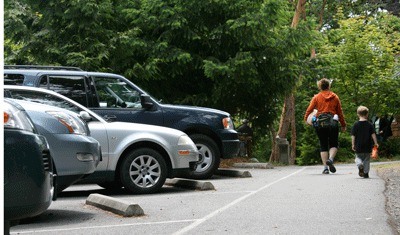With a fishing license tucked away in the tackle box and a campsite already bought and paid for, Mark Jones isn’t quite sure how far into his pocket he’ll have to dig once the new parking fees take effect at Washington’s state parks.
He’s thankful about the timing of his family’s first-ever sojourn on San Juan Island, though, which included an early afternoon visit on Saturday to Lime Kiln State Park.
“Thirty dollars is kind of steep,” Jones said of the price of state Parks’ new Discover Pass, which will be valid at any state park or state-owned recreation land for a full year. The daily cost to park is $10, and it applies to motorcycles and mopeds, as well as automobiles.
“I’m glad we’re here this week,” he said.
While uncertainty over state Parks’ parking fees, which go into effect beginning this Saturday, July 1, rippled through the ranks of those visiting the popular day-use park on San Juan Island’s west side, long-time Park Ranger William Hoppe knows that this time around there’s no turning back.
Hoppe said the financial future of state Parks, having been severed from the state’s general fund as part of the many recent cutbacks in state spending, will largely depend on the amount of money it is able to produce by cashing in on its assets, such as putting a price for parking. He noted the situation is uniquely different than it was five years ago for state Parks, when the agency repealed its three-year trial with a $5 parking fee following a sharp decline in attendance.
Then and up until the time the state’s new two-year budget takes effect, beginning July 1, Parks received a subsidy of roughly $70 million a year from the state general fund.
“We don’t really have an option now that we’re out of the general fund,” Hoppe said. “There’s nothing really left for us unless the legislature somehow changes its mind and decides to bail us out.”
Still, Hoppe said things could be worse. He noted that 70 of California’s 278 state parks are slated to be closed because of pending budget cuts.
Even as a day-use-only park, Lime Kiln remains a popular draw year after year. Home to an historic lighthouse and situated along the waterfront of scenic Haro Strait, the park, which also features the only land-based whale-watching park in the Lower 48, draws between 150,000 to 200,000 visitors a year.
With 3.5 people per vehicle, the calculation used by the park, according to Hoppe, that’s 42,000 to 57,000 cars a year.
Day passes and the annual Discover Pass can be purchased online at the state Parks’ website, at retail stores that sell hunting and fishing licenses, and at the LIme Kiln interpretive center — when it’s open.
Since the park relies on volunteers to man the center, Hoppe said its hours of operation will depend on the availability of volunteer.
Those without a Discover Pass will be obligated to fill out a self-registration envelope and insert it, along with $10, in a steel deposit box located by the center. Those who fail to pay face a $99 fine, of which Parks recoups zero. Similar to a traffic fines, the revenue is absorbed by the courts or helps to fund law enforcement.
“We don’t get a dime,” said Hoppe, adding that anyone who parks within a quarter-mile of a state park entrance is obligated, under the legislation authorizing the parking fees, to pay the parking fee as well.
Jones, visiting San Juan with his family of four from their hometown of Sammamish, has mixed feelings about parking fees.
“Part of me says, ‘aren’t we paying enough in taxes that it should cover the parks’?” he said. “But I do like that it’s universal and works at all the state parks, at least I think it will.”




